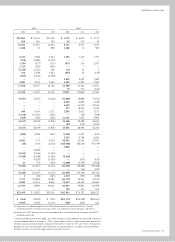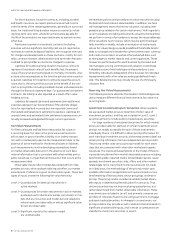GE 2012 Annual Report Download - page 79
Download and view the complete annual report
Please find page 79 of the 2012 GE annual report below. You can navigate through the pages in the report by either clicking on the pages listed below, or by using the keyword search tool below to find specific information within the annual report. GE 2012 ANNUAL REPORT 77
notes to consolidated financial statements
Preparing financial statements in conformity with U.S. GAAP
requires us to make estimates based on assumptions about
current, and for some estimates future, economic and market
conditions (for example, unemployment, market liquidity, the real
estate market, etc.), which affect reported amounts and related
disclosures in our financial statements. Although our current esti-
mates contemplate current conditions and how we expect them
to change in the future, as appropriate, it is reasonably possible
that in 2013 actual conditions could be worse than anticipated in
those estimates, which could materially affect our results of oper-
ations and financial position. Among other effects, such changes
could result in future impairments of investment securities,
goodwill, intangibles and long-lived assets, incremental losses on
financing receivables, establishment of valuation allowances on
deferred tax assets and increased tax liabilities.
Sales of Goods and Services
We record all sales of goods and services only when a firm sales
agreement is in place, delivery has occurred or services have
been rendered and collectibility of the fixed or determinable sales
price is reasonably assured.
Arrangements for the sale of goods and services sometimes
include multiple components. Most of our multiple component
arrangements involve the sale of goods and services in the
Healthcare segment. Our arrangements with multiple compo-
nents usually involve an upfront deliverable of large machinery
or equipment and future service deliverables such as installa-
tion, commissioning, training or the future delivery of ancillary
products. In most cases, the relative values of the undelivered
components are not significant to the overall arrangement and
are typically delivered within three to six months after the core
product has been delivered. In such agreements, selling price is
determined for each component and any difference between the
total of the separate selling prices and total contract consideration
(i.e., discount) is allocated pro rata across each of the components
in the arrangement. The value assigned to each component is
objectively determined and obtained primarily from sources such
as the separate selling price for that or a similar item or from com-
petitor prices for similar items. If such evidence is not available,
we use our best estimate of selling price, which is established
consistent with the pricing strategy of the business and considers
product configuration, geography, customer type, and other mar-
ket specific factors.
Except for goods sold under long-term agreements, we rec-
ognize sales of goods under the provisions of U.S. Securities
and Exchange Commission (SEC) Staff Accounting Bulletin (SAB)
104, Revenue Recognition. We often sell consumer products and
computer hardware and software products with a right of return.
We use our accumulated experience to estimate and provide
for such returns when we record the sale. In situations where
arrangements include customer acceptance provisions based
on seller or customer-specified objective criteria, we recognize
revenue when we have reliably demonstrated that all specified
acceptance criteria have been met or when formal acceptance
occurs, respectively. In arrangements where we provide goods
for trial and evaluation purposes, we only recognize revenue after
customer acceptance occurs. Unless otherwise noted, we do not
provide for anticipated losses before we record sales.
We recognize revenue on agreements for sales of goods and
services under power generation unit and uprate contracts,
nuclear fuel assemblies, larger oil drilling equipment projects,
aeroderivative unit contracts, military development contracts,
locomotive production contracts, and long-term construction
projects, using long-term construction and production contract
accounting. We estimate total long-term contract revenue net of
price concessions as well as total contract costs. For goods sold
under power generation unit and uprate contracts, nuclear fuel
assemblies, aeroderivative unit contracts, military development
contracts and locomotive production contracts, we recognize
sales as we complete major contract-specified deliverables, most
often when customers receive title to the goods or accept the ser-
vices as performed. For larger oil drilling equipment projects and
long-term construction projects, we recognize sales based on our
progress towards contract completion measured by actual costs
incurred in relation to our estimate of total expected costs. We
measure long-term contract revenues by applying our contract-
specific estimated margin rates to incurred costs. We routinely
update our estimates of future costs for agreements in process
and report any cumulative effects of such adjustments in current
operations. We provide for any loss that we expect to incur on
these agreements when that loss is probable.
We recognize revenue upon delivery for sales of aircraft
engines, military propulsion equipment and related spare parts
not sold under long-term product services agreements. Delivery
of commercial engines, non-U.S. military equipment and all related
spare parts occurs on shipment; delivery of military propulsion
equipment sold to the U.S. government, or agencies thereof,
occurs upon receipt of a Material Inspection and Receiving Report,
DD Form 250 or Memorandum of Shipment. Commercial aircraft
engines are complex equipment manufactured to customer order
under a variety of sometimes complex, long-term agreements.
We measure sales of commercial aircraft engines by applying our
contract-specific estimated margin rates to incurred costs. We
routinely update our estimates of future revenues and costs for
commercial aircraft engine agreements in process and report
any cumulative effects of such adjustments in current opera-
tions. Significant components of our revenue and cost estimates
include price concessions, performance-related guarantees as
well as material, labor and overhead costs. We measure revenue
for military propulsion equipment and spare parts not subject to
long-term product services agreements based on the specific
contract on a specifically measured output basis. We provide for
any loss that we expect to incur on these agreements when that
loss is probable; consistent with industry practice, for commercial
aircraft engines, we make such provision only if such losses are
not recoverable from future highly probable sales of spare parts
for those engines.
We sell product services under long-term product mainte-
nance or extended warranty agreements in our Aviation, Power
& Water, Oil & Gas and Transportation segments, where costs
of performing services are incurred on other than a straight-
line basis. We also sell product services in our Healthcare
segment, where such costs generally are expected to be on a
straight-line basis. For the Aviation, Power & Water, Oil & Gas and
Transportation agreements, we recognize related sales based
on the extent of our progress towards completion measured
























